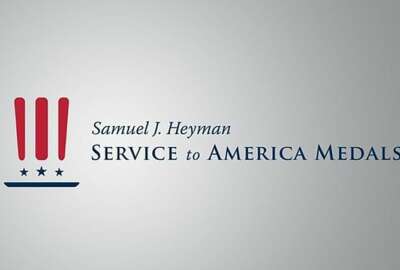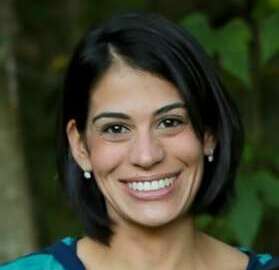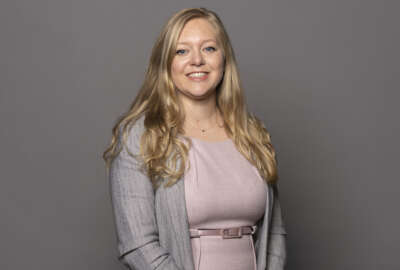
Hubbard Radio Washington DC, LLC. All rights reserved. This website is not intended for users located within the European Economic Area.
Hubbard Radio Washington DC, LLC. All rights reserved. This website is not intended for users located within the European Economic Area.
Krista Kinnard is a finalist in the emerging leaders category of this year's Service to America Medals program. She serves as chief of emerging technology at th...
Best listening experience is on Chrome, Firefox or Safari. Subscribe to Federal Drive’s daily audio interviews on Apple Podcasts or PodcastOne.
She’s only in her mid-30s. But she’s already reduced paperwork and drudgery at the Labor Department. Now she’s a finalist in the emerging leaders category of this year’s Service to America Medals Program. Labor’s Chief of Emerging Technology, Krista Kinnard, spoke with the Federal Drive with Tom Temin .
Interview transcript:
Tom Temin: Let’s begin with the beginning. You are the chief of emerging technology. Tell us about your job, what is emerging technology, and where in the technological hierarchy at Labor does that position kind of live?
Krista Kinnard: So the good news is this position was created when I took it. It’s a new position for the Department of Labor, and we sit in the CTO’s shop. So the Chief Technology Officers shop, and really what the emerging technology division is designed to do, is to partner with the different mission areas at the Department of Labor, and really start to understand what is it that they do? What is their day-in, day-out? What is their business value? What is the mission they’re trying to deliver to the American people? And how can we be thinking about in the 21st century, how can we improve that service? How can we make it efficient? How can we make it more effective? And sometimes that means, right there on the front line where the citizen is engaging with the Department of Labor? And sometimes that means looking at our back office to see how can we make sure that the employees here at the Department of Labor have the tools and the technology that they need to be able to do their job quickly, efficiently and effectively? And as we know, in this environment that we now live in, technology changes every single day. How many times have you been annoyed because an application on your phone got updated, and they didn’t tell you what the new updates were? Or new features are coming out in your email or in your favorite music app. And the idea behind the emerging technology division is we want to bring that technology to the Department of Labor, we want to bring the Department of Labor and how we deliver on our mission into the 21st century. That means embracing new technologies like automation, artificial intelligence, and whatever else is coming down the pipeline.
Tom Temin: All right, give us an example of where something like an automation type of algorithm or machine learning type of application might have helped here.
Krista Kinnard: Yeah, absolutely. So we have a number of examples that we could pull from, I think one of the ones that we’re most proud of is using robotics process automation, called RPA for short. And despite the name, there are no actual robots involved. But really, it’s creating a streamlined process where we can automate some of our procurement procedures. So anyone who’s worked in the government space knows that procurement is a really big part of what we do. It is also a beast of a task. It really involves a lot of people, a lot of really rigorous investigation to make sure that we’re responsibly engaging with the vendor community. Our procurement professionals, they are slammed. They are sharp, they know their job really well. But they have so many of these that they’re going through on a regular basis, that we were actually able to create a number of bots. Bots is what we call them in the automation space to automate a few of those tedious tasks, to help free up these procurement professionals to really focus on the parts that require that thinking ability that humans are highly trained for. Some of those tedious tasks that you’re like, oh, my gosh, I’m spending all my time clicking around or trying to log in or searching down this piece of information that if I just had it at my fingertips, I could get this done in two seconds. But I’m spending an hour going around trying to find the information that I need to make this decision. So we actually have taken this process, one of our pride processes is for evaluating contractor responsibility. Every contracting professional when they’re going to do a contract has to ensure that that vendor is responsible and will be able to perform on the duties they say they can. And that of course requires an investigation. So now we have a bot that’s able to go and find all of that information that that procurement professional would need to make their decision. And I want to be clear, these bots do not make decisions. What they do is they get all of the information that that procurement professional needs at their fingertips, they can make that decision quickly. And we’ve actually been able to reduce the time that an individual procurement professional can do this task from an hour to three minutes.
Tom Temin: All right, wow. we’re speaking with Krista Kinnard. She’s chief of emerging technology at the Labor Department and a finalist in this year’s emerging leaders category of this year’s Service to America Medals Program. So the implication is you spend a lot of time with those functional areas to make sure that what it is you want to deliver is what they expected, need. Because sometimes in technology, that doesn’t always work out so well.
Krista Kinnard: Exactly. And I think one of the greatest parts of the emerging technology group that I lead is we’re not playing with technology just for the sake of it. I love being a part of government. We are exploring new technologies to really serve the American people. And you can really see the impact.
Tom Temin: And just tell us about the office itself. You said you supervise some people, how large is your crew? And and what types of skills make up the staff?
Krista Kinnard: Currently, we are a small but mighty federal team. I have two direct reports. And they focus in different areas, we have one who is our automation lead, and he focuses specifically on our robotic process automation program. So he’s the one on the frontline talking to the mission areas. Understanding, alright, so you want to automate a process? What’s step one, what’s step two, what’s step three, and then he converts it into that automated process. And then our other IT specialist, she focuses on our artificial intelligence capability. And she really has a focus on our responsible implementation of AI. We also have a team of contractors that help us out that is changing in number rapidly, and it’s going up because we are growing and expanding. And as more of the department learns about us, there’s more of a need for our services, which is really exciting.
Tom Temin: And of course, the cliche you hear all the time about the government is it’s all baby boomers and generation, whatever came after that I can’t keep track of all the letters and numbers, but it’s an aging population. And young people don’t want to go into government, but you belie that trend. Tell us about your background briefly and how you came to government service.
Krista Kinnard: I’ve always been dedicated to public service. And actually, my first experience with government was when I was in the Peace Corps. This was many years ago, when I first graduated from undergraduate and through my time actually in Peace Corps and then returning to the United States and working in kind of the nonprofit space. I really got to see how data-driven decision making is so critical in what we do in government. So when I went back, I got my master’s degree specifically in data science and public policy, because I wanted to focus on how can we take all this data that we’re collecting, and really use it to benefit the American people to benefit how we deliver services to how we make our government more efficient. That’s what has led me to government, I entered government at GSA and then quickly transitioned over here to DOL.
Tom Temin: And how do you like it? I mean, DOL just has a reputation for being a little bit on the stodgy side sometimes, and has a workforce, like HHS, in certain of its components that tend to stay in place, partly because of the mission, but for a really long time.
Krista Kinnard: I absolutely love it. I love my job. I would encourage young people around the world, please get involved with government. It’s a really rewarding career. And I’m here to change that perception, right. I mean, the perception is that government is stodgy and it doesn’t have to be, and the government of the future is going to meet people like us to be able to drive change, to be able to make sure that we can continue to serve the populations and the communities that we do. And I think government is ready for us. It takes a little bit of patience, right? We all know, government, broadly, not just DOL is a little bit bureaucratic. And I think sometimes with good reason and slower than the private sector again with with good reason. But I am very optimistic for the future of government and how we are going to be able to continue to deliver on the Department of Labor’s mission to the American people.
Tom Temin: Krista Kinnard is chief of emerging technology at the Labor Department and a finalist in the emerging leaders category of this year’s Service to America Medals program.
Copyright © 2024 Federal News Network. All rights reserved. This website is not intended for users located within the European Economic Area.
Tom Temin is host of the Federal Drive and has been providing insight on federal technology and management issues for more than 30 years.
Follow @tteminWFED


